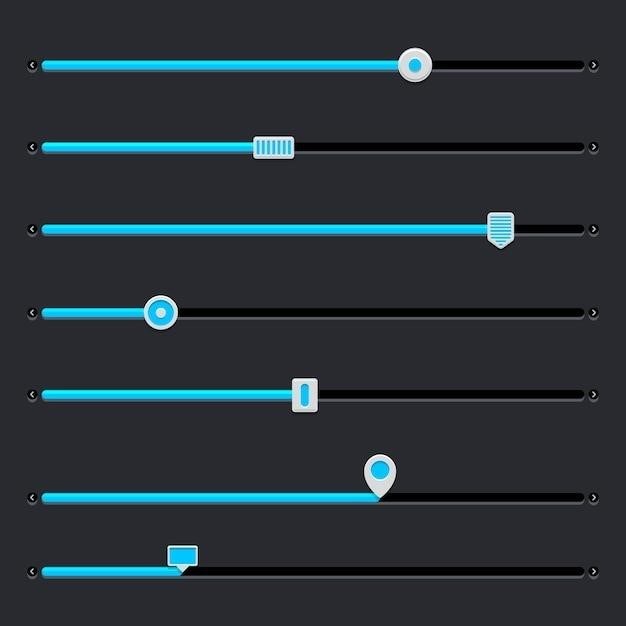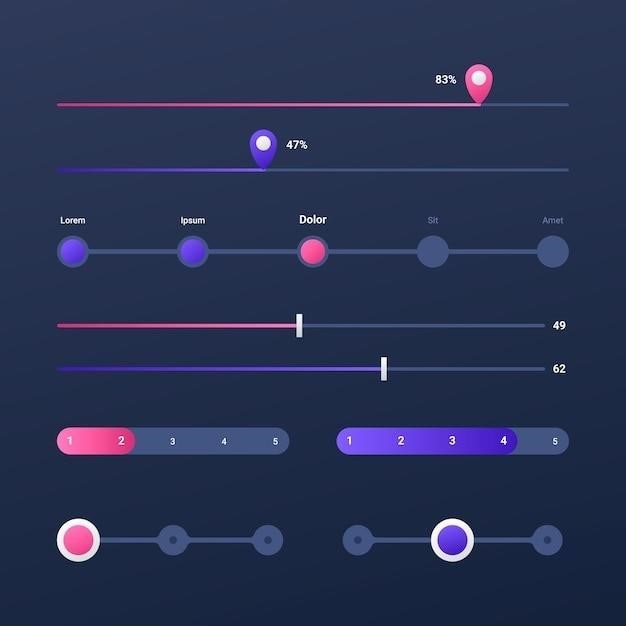Guiding Bar Design⁚ An Overview
Guiding bar design encompasses various aspects‚ from optimizing bartender workflow and efficient layout strategies to creating a memorable ambiance. Careful consideration of space planning‚ equipment placement‚ and aesthetic choices is crucial for success. Effective design balances functionality with style‚ resulting in a profitable and inviting space.
Types of Guiding Bars
The term “guiding bar” lacks a universally standardized definition across various industries. However‚ based on the provided text‚ we can infer a few interpretations. In a mechanical context‚ a guiding bar might refer to components like the crosshead guide in a steam engine‚ ensuring piston rod movement remains parallel to the cylinder. Alternatively‚ in electrical engineering‚ a “busbar” acts as a conductor distributing power‚ sometimes configured as vertical risers in multi-story buildings. Finally‚ within the context of user interface design‚ a “navigation bar” guides users through websites or applications‚ employing various patterns such as top or side bars. The specific type of “guiding bar” depends entirely on the application.
Commercial Bar Design Considerations
Designing a commercial bar requires a multifaceted approach prioritizing both functionality and aesthetics. Key considerations include optimizing the bartender’s workflow for maximum efficiency‚ ensuring easy access to all necessary equipment and supplies. The layout should facilitate smooth customer flow‚ preventing bottlenecks and maximizing seating capacity. Material selection is critical; durable‚ easy-to-clean surfaces are essential for high-traffic environments. Lighting and décor must create a welcoming ambiance‚ reflecting the bar’s brand and target clientele. Careful attention to these factors contributes to a successful‚ profitable commercial establishment. Remember‚ a well-designed bar is more than just a place to serve drinks; it’s a carefully crafted experience.
Residential Bar Design Ideas
Transforming a corner of your home into a stylish bar area is achievable with thoughtful planning. Consider the available space; a small corner can house a compact bar cart‚ while larger areas allow for built-in units. Choose a theme that reflects your personal style‚ from a sleek‚ modern design to a rustic‚ vintage aesthetic. Incorporate functional elements like ample storage for glassware and spirits‚ along with an ice maker or refrigerator for convenience. Lighting plays a key role; ambient lighting creates a relaxed mood‚ while task lighting illuminates the bar area. Don’t forget comfortable seating—bar stools or armchairs—to encourage socializing. Add personal touches with artwork‚ decorative accents‚ and unique glassware to create a space that is both functional and aesthetically pleasing‚ reflecting your individual taste and creating a perfect home happy hour haven.

Guiding Bar Functionality and Efficiency
Efficient bar design prioritizes smooth workflow. Strategic layout and equipment placement minimize bartender movement‚ maximizing speed and service. This boosts profitability and enhances the customer experience. A well-designed bar is a well-oiled machine.
Optimizing Bartender Workflow
Optimizing bartender workflow is paramount for efficient bar operation. A well-designed bar prioritizes minimizing unnecessary movement for bartenders. This involves strategic placement of equipment like ice wells‚ sinks‚ and glassware storage. Keeping frequently used items within easy reach reduces wasted steps and increases speed of service. The layout should also consider the natural flow of work‚ from receiving orders to preparing and serving drinks. Consider incorporating a three-sided bar design to allow for easy access from multiple angles. This allows for better handling of multiple orders simultaneously‚ reducing wait times for customers. Ergonomic considerations are also crucial. The height of the bar‚ the placement of shelves‚ and the overall layout should be designed to minimize strain and fatigue for bartenders‚ promoting comfort and efficiency. A comfortable and efficient workspace translates to better service and higher productivity.
Efficient Bar Layout Strategies
Efficient bar layout strategies are crucial for maximizing space and workflow. The arrangement of the bar itself‚ including the placement of the ice well‚ speed rail‚ and other essential equipment‚ significantly impacts a bartender’s efficiency. A well-designed bar should facilitate a smooth and logical flow‚ minimizing unnecessary steps. Consider the “triangle” approach‚ positioning key areas – ice‚ glassware‚ and liquor – in a triangular formation to minimize travel distance. Furthermore‚ adequate space for both bartenders and customers is vital. Sufficient counter space allows for drink preparation and customer interaction without feeling cramped. The layout should also accommodate customer traffic flow‚ preventing congestion and bottlenecks. Careful consideration of seating arrangements‚ including bar stools and tables‚ is essential for a comfortable and functional space. Think about incorporating different zones for different functions‚ such as a separate area for cocktail preparation or a dedicated space for speed service. A well-planned layout contributes to a more efficient and enjoyable experience for both staff and patrons.
Space Planning and Equipment Placement
Effective space planning and equipment placement are fundamental to a well-functioning bar. Careful consideration of the bar’s dimensions is crucial‚ ensuring sufficient space for both staff and customers to move freely without congestion. The placement of key equipment‚ such as the ice well‚ sinks‚ and speed rail‚ should optimize workflow‚ minimizing unnecessary movement by the bartender. Strategic placement of these elements can significantly reduce time wasted searching for items‚ increasing efficiency. Consider incorporating modular elements to adjust the bar’s configuration as needed‚ accommodating fluctuations in customer volume. Adequate storage for glassware‚ liquor‚ and other supplies is also essential‚ keeping the workspace organized and clutter-free. The height of the bar should be carefully planned to provide comfortable seating for customers and easy access for bartenders. Moreover‚ the integration of technological tools‚ such as POS systems‚ should be seamless‚ improving order management and minimizing disruption to the workflow. Proper space planning and equipment placement enhance operational efficiency and contribute to a more enjoyable experience for both the staff and the patrons.

Aesthetic Considerations in Guiding Bar Design
A bar’s aesthetic significantly impacts customer experience. Careful selection of lighting‚ decor‚ color schemes‚ and materials creates a welcoming and memorable ambiance‚ encouraging repeat visits. The overall design should reflect the bar’s brand and target audience.
Creating a Memorable Ambiance
Crafting a memorable ambiance in a bar is paramount to its success. The atmosphere should align with the bar’s concept and target clientele. A sophisticated cocktail bar might feature dim lighting‚ plush seating‚ and elegant decor‚ while a lively pub could opt for brighter lighting‚ rustic elements‚ and communal tables. Music plays a crucial role; a carefully curated playlist can enhance the mood and create a specific atmosphere. Consider incorporating unique design elements‚ such as a custom-made bar top or eye-catching artwork‚ to add character and personality. The use of textures‚ such as exposed brick or reclaimed wood‚ can add warmth and visual interest. Paying attention to even the smallest details‚ from the glassware to the napkins‚ can contribute to a cohesive and unforgettable experience. Ultimately‚ the goal is to create a space where patrons feel comfortable‚ relaxed‚ and eager to return.
Lighting and Decor Choices
Strategic lighting and decor choices are essential in shaping a bar’s ambiance. Lighting can dramatically alter the mood‚ from a warm and inviting glow to a vibrant and energetic atmosphere. Consider using a combination of ambient‚ task‚ and accent lighting to create layers of illumination. Ambient lighting provides overall illumination‚ while task lighting focuses on specific areas like the bar top. Accent lighting highlights architectural details or artwork‚ adding visual interest. Decor should complement the lighting and overall design concept. The selection of materials‚ such as wood‚ metal‚ or stone‚ influences the bar’s aesthetic. Artwork‚ plants‚ and other decorative elements can add personality and create focal points. Remember that the decor should be functional as well as visually appealing‚ ensuring that there is sufficient space for patrons and staff to move around comfortably. Careful consideration of these elements will contribute to a cohesive and inviting space.
Color Schemes and Material Selection
Color schemes and material selection play a crucial role in defining the aesthetic and atmosphere of a guiding bar. Warm‚ inviting colors like deep reds‚ rich browns‚ and golden yellows can create a cozy and sophisticated ambiance‚ ideal for a traditional pub or upscale cocktail lounge. Conversely‚ cooler tones such as blues‚ greens‚ and grays can evoke a modern and sleek feel‚ suitable for a contemporary bar or gastropub. The choice of materials significantly impacts the overall design. Wood adds warmth and texture‚ while metal provides a modern and industrial edge. Stone‚ particularly marble or granite‚ creates a luxurious and elegant atmosphere. Consider the durability and maintenance requirements of each material. For example‚ wood may require more upkeep than metal or stone. The interplay of colors and materials should be carefully considered to create a cohesive and visually appealing space that complements the overall design concept and target clientele.
Guiding Bar Design Resources and Inspiration
Seek inspiration from online design guides‚ professional bar design services‚ and examples of successful bar designs. Explore various styles and layouts to find the perfect fit for your vision.
Online Design Guides and Tutorials
The internet offers a wealth of resources for guiding bar design. Numerous websites and blogs provide comprehensive guides‚ covering everything from initial conceptualization to final implementation. These online resources often include detailed diagrams‚ 3D models‚ and step-by-step instructions‚ making them invaluable tools for both novice and experienced designers. Many tutorials focus on specific aspects of the design process‚ such as optimizing bartender workflow‚ efficient bar layout strategies‚ and creating a memorable ambiance. You can find examples showcasing successful bar designs‚ offering practical inspiration and innovative ideas to incorporate into your own project. Interactive tools and design software are also readily available online‚ enabling users to experiment with different layouts‚ color schemes‚ and material selections before committing to a final design. These online resources serve as a dynamic and ever-expanding library of information‚ ensuring that designers have access to the latest trends‚ techniques‚ and best practices in the field of guiding bar design.
Professional Bar Design Services
Engaging professional bar design services offers significant advantages throughout the design process. Experienced designers possess in-depth knowledge of industry best practices‚ ensuring optimal functionality and efficiency. They can expertly navigate complex design challenges‚ such as space optimization and equipment integration‚ maximizing the bar’s potential. Professional services often incorporate advanced 3D modeling and visualization‚ allowing clients to experience their bar design before construction begins. This collaborative approach ensures the final product aligns perfectly with the client’s vision‚ incorporating their unique preferences and requirements. Beyond aesthetics‚ professional designers prioritize safety and regulatory compliance‚ adhering to all relevant building codes and industry standards. Their expertise extends to material selection‚ sourcing high-quality and durable materials tailored to the specific needs of a bar environment. The resulting design is not just visually appealing but also built to withstand the demands of daily operation‚ ensuring longevity and cost-effectiveness in the long run. Professional guidance streamlines the entire process‚ minimizing potential setbacks and ensuring a smooth transition from concept to completion.
Examples of Successful Bar Designs
Analyzing successful bar designs reveals key elements contributing to their effectiveness. HiLot in New York City‚ for instance‚ showcases a blend of retro aesthetics and modern functionality‚ creating a unique and memorable atmosphere. The attention to detail‚ from disco balls to a bathtub in the restroom‚ demonstrates how thoughtful design choices enhance the overall experience. Conversely‚ minimalist designs‚ focusing on clean lines and efficient layouts‚ can be equally successful‚ particularly in smaller spaces. The key is a balanced approach; functionality should never overshadow ambiance‚ and vice versa. Examining successful examples highlights the importance of considering target clientele. A high-end cocktail bar will require a different design approach than a casual pub‚ with variations in material selection‚ lighting‚ and overall layout reflecting the intended customer base. Studying case studies‚ whether through online resources or industry publications‚ provides valuable insight into successful design strategies. These examples can inspire creativity and inform decision-making‚ helping to shape a unique and successful bar design tailored to specific needs and preferences.